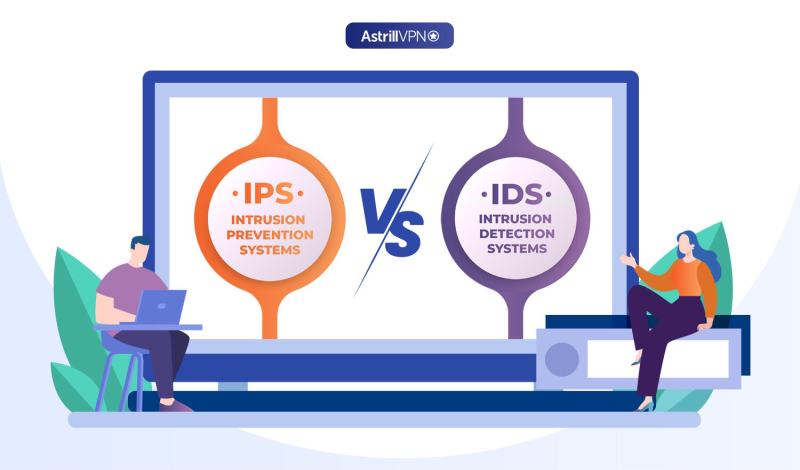IPS vs. IDS: The Difference between Intrusion Prevention and Detection Systems

Arsalan Rathore

The risks posed by cyberattacks are higher than they’ve ever been. Tools like intrusion detection systems (IDS) and intrusion prevention systems (IPS) that combine signature databases with AI are invaluable for helping IT teams strengthen their security posture against sophisticated cyber threats.
Let’s dive into the details and see how these systems work and what are the differences between the two:
Table of Contents
How do Intrusion Detection Systems (IDS) work?
The IDS keeps track of network traffic and notifies the user when it notices any unusual activity. The user can take action to identify the underlying cause and fix the issue after receiving the notice.
There are two types of IDS systems:
- Network Intrusion Detection System (NIDS): Through network-wide sensors, NIDS keeps an eye on network traffic for security issues.
- Host Intrusion Detection System (HIDS): HIDS keeps track of all activity on the system or device where it is installed.
How do Intrusion Prevention Systems (IPS) work?
An intrusion prevention system (IPS) is a type of network security system that monitors network traffic for malicious activity and takes appropriate action to stop it. The IPS is positioned in the network’s backend, and it just like IDS, also utilizes signature or anomaly detection to flag malicious activity.
In its most basic form, an IPS may be thought of as an IDS with the addition of active prevention. Intrusion Prevention Systems (IPS) is an essential part of today’s business security infrastructure. Organizational networks in 2022 have many points of entry and handle large amounts of data, making it difficult to keep tabs on all of the traffic and deal with security concerns manually.
Differences between IDS and IPS
| IDS (Intrusion Detection Systems) | IPS (Intrusion Prevention Systems) |
|---|---|
| The IDS does not block any cyber attack or suspicious attempt. Rather, it only alerts the user that there has been an intrusion or attempt of intrusion. | The IPS responds instantly to any suspicious attempts and blocks the threat. Unlike IDS, it tries to prevent intrusions. |
| The number of false positives is higher in IDS and it can cause interruptions. | The IPS are improving over time as the companies are enhancing the machine learning infrastructure. Therefore, the chances of false positives are lower in IPS. |
| One of the drawbacks of IDS is that it relies on human admins. It alerts the admins and then they have to manually block the threat. | IPS is AI and machine learning based, which is why it blocks the threat itself and does not require any human admin. |
| The best option for internal networks and websites with low traffic. | Best for websites with high traffic volume from various regions. |
Similarities Between IDS and IPS
Following are some of the similarities between IDS and IPS:
- Both of the systems are built for networks with multiple entry points and high traffic volume.
- Both IDS and IPS use signature-based and Anomaly-based approaches for identifying and dealing with intrusions.
- Both IDS and IPS have a common capacity to apply policies aimed at ensuring the safety and morality of corporate activities.
Why are IDS and IPS solutions important?
Cyberattacks that target a company’s information assets should be avoided at all costs, making solutions like IDS (intrusion detection systems) and (intrusion prevention systems) extremely valuable.
Cyber attacks can have devastating results as Investopedia reported that around 6% of businesses have paid a ransom to recover access to their data. Organizations typically lose over $2.45 million when malware is used to disrupt their operations. You may protect yourself from cyber threats with the use of solutions like intrusion detection systems (IDS) and intrusion prevention systems (IPS).
Cybercriminals use DDoS attacks, brute force attacks, and vulnerability exploits to bring down businesses; IDS and IPS can detect all three. Therefore, most businesses should incorporate both into their cybersecurity strategies.
Companies now function in highly linked settings thanks to the widespread adoption of cloud technologies. This has many advantages, but if the cloud platform isn’t properly protected, it also opens up a lot of entry points for attackers. This calls for the timely and proper implementation of IDS and IPS systems.
IDS Or IPS; Which One to Choose?
When it comes to safety, every business and user has various requirements since they encounter unique dangers and problems. While an Intrusion Prevention System (IPS) would be appropriate for a single business’s private network, an Intrusion Detection System (IDS) might be more practical for a big website with several servers.
In order to reduce the number of potential ports of access to your network, a proactive cybersecurity plan is essential. To be prepared for when cyberattacks do occur, IPS and IDS solutions help you detect them. In most cases, an IPS (Intrusion Prevention System) is the best choice for businesses that wish to cut down on time spent on security issues.

No comments were posted yet